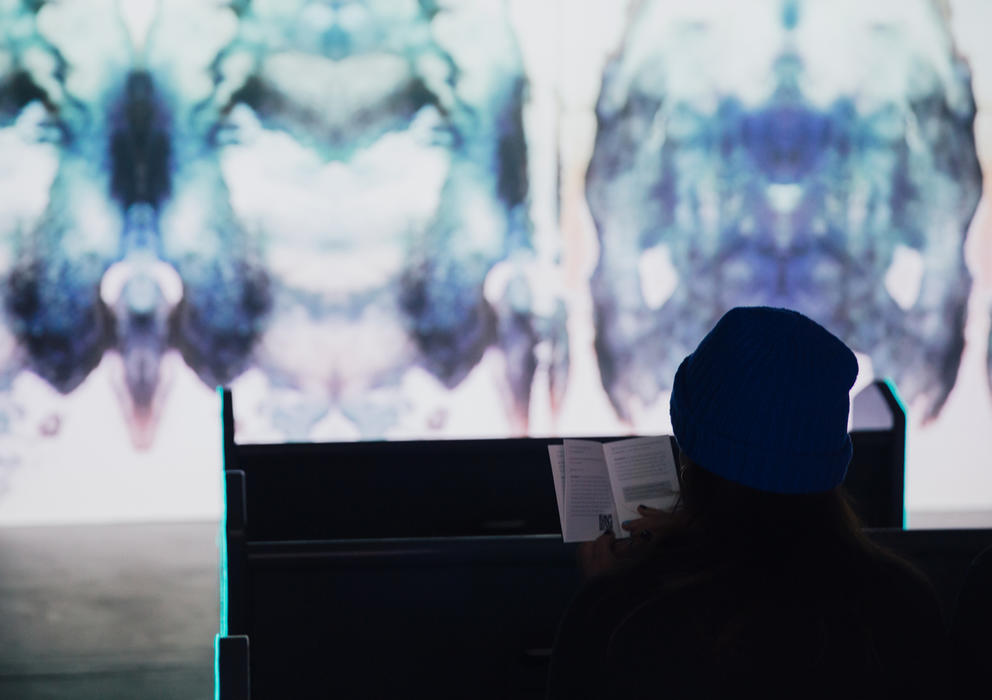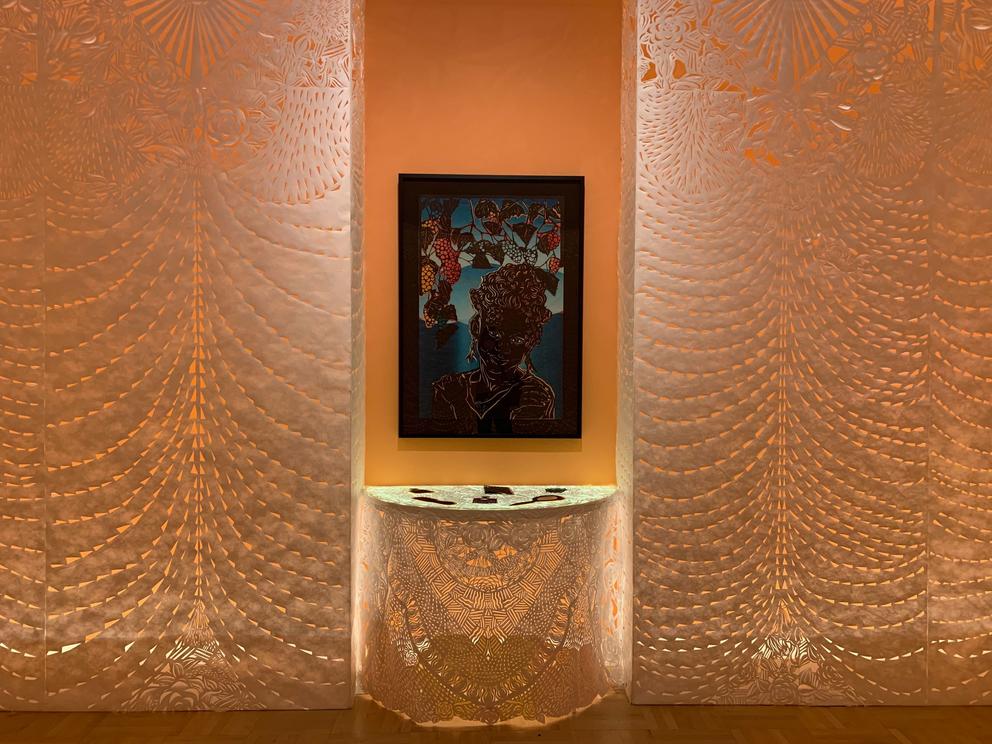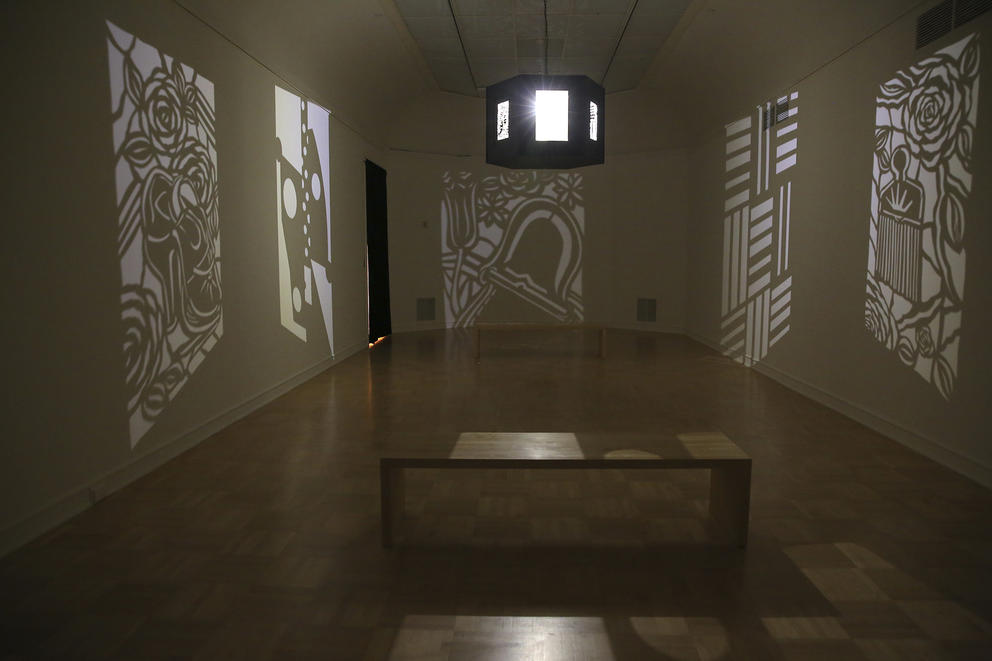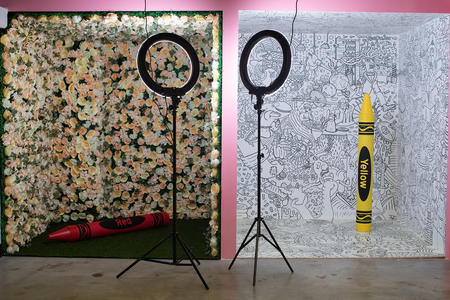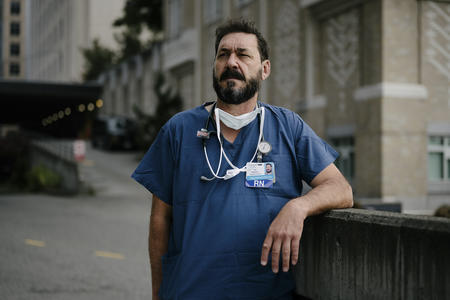In fact, Come on In (through Nov. 6) is an interactive, immersive exhibition by New York-based choreographer Faye Driscoll at Uptown performance center On the Boards, where the stage has been transformed into a spacious and curtained room. Visitors take off their shoes, walk across a soft black rug and choose one of six white minimalist beds, pedestals lit from above, like a spa from some uncanny valley.
Although Driscoll herself doesn’t much like the idea of calling Come on In “immersive,” the show is part of a slew of new Seattle art exhibitions that take a 360-degree approach. Not bound by a frame, pedestal or stage, the art surrounds the audience — inviting people to experience it from the inside.
So-called “immersive” art exhibits have been en vogue for a few years now (think: Yayoi Kusama’s hyper-popular “Infinity Mirror Rooms” from a few years back), but the concept has gained more widespread attention lately, in part thanks to a recent explosion of “Immersive Experiences,” where visitors can step into giant, animated projections of paintings by Vincent Van Gogh or Monet. The titles spell it out: Van Gogh: The Immersive Experience. Immersive Van Gogh. Claude Monet: The Immersive Experience — you get the point (it’s immersive).
On the occasion of Van Gogh: The Immersive Experience landing in Seattle (Oct. 19 through January), I visited three new “immersive” alternatives. These local exhibits offer a sensory experience on a smaller (less branded) scale, and take it further by asking viewers to consider matters of identity, self-awareness, race, media and technology. These shows are for people who want a contemplative and contemporary art experience, who seek to support local art venues — and for Van Gogh fans who need an immersive fix until they can step inside “Starry Night.”
“Make yourself really comfortable,” Driscoll coaxes back at On the Boards, where each bed has a set of headphones playing different sets of meditative cues. “Come on in. Go to your softest, softest place.” Later, she’ll gently suggest I wiggle my toes, let my tongue hang out, lift up my open arms towards the sky.
“Bring your attention to your face, your face, your face,” Driscoll encourages in another audio fragment. “Notice the residue of facial recognition software softly caressing your cheeks. Come on. Feel it.”
“Many of these [audio fragments] are written as activations, prompts to the dead parts of us,” Driscoll told me in a recent email. “The ways perhaps we are dissociated, addicted, and have left our bodies in the dust of ‘progress.’ ”
Driscoll started working on this exhibition before the pandemic, but the work has since become eerily apt. “It’s as if I was making it for something I did not know was about to happen. Art is so weird like that! Each on our own separate pedestal, close but at a distance, dependent on technology, weirdly intimate and yet removed and observing ourselves,” she says.
Technology is also at the center of a new show at the Museum of Museums, where the top floor is dedicated to rotating, immersive exhibits by local artists. For The Word of the Future, which opened earlier this month (through Dec. 27), Seattle artists Jacob Peter Fennell and Reilly Donovan have transformed the space into a futuristic house of worship.
Six gray pews framed by turquoise electroluminescent wire face a 22-foot-wide screen on the wall of a darkened room. Onscreen, Rorschach inkblots bleed and distort into ungraspable, constantly shifting colors and shapes. And here, too, a disembodied voice speaks as I sit in the stiff seats.
“You’re an examiner,” the voice booms down from the speakers. Is that … David Attenborough narrating the Gospel? “This method of training machines of finding out what to do by doing it is known as active learning,” the voice says, not quite making grammatical sense. “And it’s used widely in artificial intelligence.”
Though Donovan and Fennell are the artists and creators of this art show, they are not, in a technical sense, the creators of the inkblots — nor of the text, Gregorian chants playing overhead or images of rosaries and stained glass windows on screens near the entrance. At work here are several artificial intelligence entities (or “agents”), large neural models the artists fed with thousands of books on philosophy and theories of mind, or images of rosaries and stained glass windows. Then Donovan and Fennell programmed these neural networks to re-create these concepts on their own.
And, no, Attenborough did not read the “The Word of the Future.” That, too, is a computer program, one trained to read the text it generates in the voice of the famous British naturalist.
“A big part of this [show] is about how belief shapes one’s reality,” Fennell told me during a recent visit, as we sat on benches near four screens showing blurry images of rosaries and church windows. It seemed as if “the agent” had grasped the idea, but not quite the shape.
“Organized religion was one way for belief to shape communities to get together to do great things and also, to commit great atrocities,” he says. Artificial intelligence can be like that, too. It is shaped by the media it is fed and the biases of its creators. The crux of this show: AI is not some futuristic reality — it is already here, and “we need to be involved if we don’t want to end up with certain biases,” Fennell says.
Packaged Black, a vibrant new exhibit at the Henry Art Gallery (through May 1, 2022), offers another intriguing inquiry into how media — along with myth, fairy tales, commerce and pop culture — shape social expectations and conceptions of self, specifically Black identity. The show pairs work by Seattle artist Barbara Earl Thomas and New York-based Derrick Adams, who both use geometric patterns and layers (of cut paper, clothing patterns, fabric) to sample and collage vivid portraits, paintings and sculptures.
While it’s easy to get caught up in the splendid colors bursting forth from the large-scale paintings, paper-cuts and sculptures, two galleries in the show offer a fully immersive experience.
One is “Rotating Lantern,” a collaborative work by Adams and Thomas intended for “otherworldly imagining.” As music by Dionne Warwick, Prince and Anita Baker plays overhead, a rotating lantern in the heart of the gallery casts cut-paper images across the room’s bare, white walls. The technique recalls the earlier magic-lantern work of artists Auguste Edouart and Kara Walker. But here, there are no silhouetted people, only abstracted monochrome shapes of cut fabric patterns (Adams) and stained-glass-like cutouts of an Afro pick and a cinderella shoe surrounded by roses (Thomas).
Listening to the retro music playing overhead, I watched the carousel of paper cuttings shift across the room, as if dancing on the wall.
In the neighboring space, Thomas’ “Transformation room” is lit in a more spectral glow. Golden light oozes through meticulously hand-cut slits and incisions in large, backlit Tyvek scrolls. Images of cascading garlands and sunbeams adorn the room, converting it into a paper-thin Versailles. In the middle of one wall is an altar of sorts, featuring a paper painting of a girl (a princess or a queen?) with her hair coiffed high. Her face is lit up by the light blue background seeping through the cut black paper, like stained glass. On her dresser: a comb, mirror, pick, all made from paper.
When I attend art shows, I usually walk around with my phone in hand, furiously documenting the work on view, but I didn’t take any pictures here. It seemed like the room’s luminous energy nudged me to stop, take a moment and activate a sense of wonder, a mental immersion so rare in this attention economy.
“Anytime you step into a dressing room, it’s like you are divesting yourself of whatever your reality is, and now you’re in a transformative space where you get to reinvent yourself right there,” Thomas tells Adams in a conversation transcribed for the show’s brochure. “That’s what we’re doing every day,” Thomas says. “We’re all trying to reinvent ourselves. I’m now trying to reinvent myself. How do I step out into the world and feel good?”
Get the latest in local arts and culture
This weekly newsletter brings arts news and cultural events straight to your inbox.



